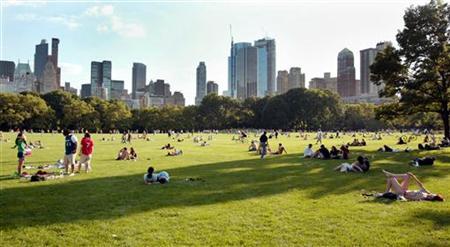Living By Green Spaces Can Boost Body And Soul: Study
Country: US
Author: Amy Norton from Reuters Health

People spend time in the Sheeps Medow at New
York's Central Park, July 19, 2003.
Photo: Jeff Christensen
NEW YORK - People who live near green spaces may be less likely than those surrounded by concrete to suffer a range of health problems, particularly depression and anxiety, according to a Dutch study.
Researchers from the VU University Medical Center in Amsterdam found that among more than 300,000 Dutch adults and children, those living near more "green spaces" tended to have lower rates of 15 different health conditions.
They found the link was especially strong when it came to depression and anxiety, suggesting that respite from stress and the hustle and bustle of urban life may be an important for reason for the benefits of green.
Past studies have found that people who live in greener environments tend to report better subjective health.
But this study, published in the Journal of Epidemiology and Community Health, is the first to use objective data on specific mental and physical health diagnoses, researcher Dr. Jolanda Maas told Reuters Health.
The findings build on evidence that green space has a positive effect on health and is "more than just a luxury good," Maas said.
She and her colleagues gathered their information from the electronic medical records of 345,143 patients of about 200 general practitioners.
They used an environmental database on land use to gauge the percentage of green space in the patients' neighborhoods.
Overall, the study found, greater amounts of green space within one kilometer -- or 0.6 miles -- of people's homes was related to small reductions in the risks of health problems like heart disease, diabetes, chronic neck and back pain, asthma and migraine.
The strongest connection was seen with depression and anxiety.
Among people who lived in areas with 90 percent green space, for example, just over 2 percent had been diagnosed with depression, compared with just over 3 percent of those living in areas with 10 percent green space.
Maas and her colleagues point out that greener environs could potentially have positive affects on health through a number of pathways, including better air quality and more opportunities for exercise.
But, the researchers added, the link with depression and anxiety suggests that stress reduction and a lesser likelihood of "attention fatigue" could be especially important. The study also found that the relationship between green space and health was particularly strong among children and lower-income groups, which, the researchers speculate, could be because they tend to spend much of their time close to home.
(Editing by Belinda Goldsmith)
© Thomson Reuters 2009 All rights reserved
